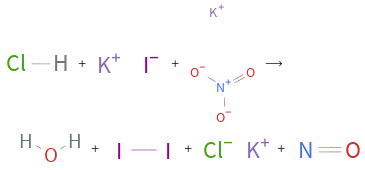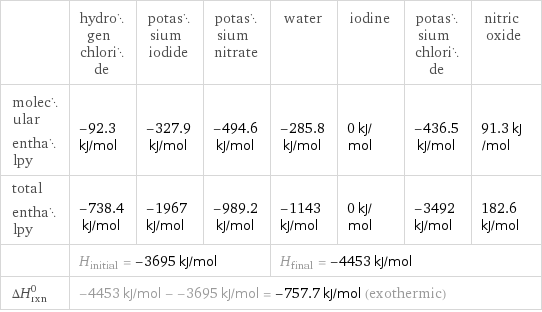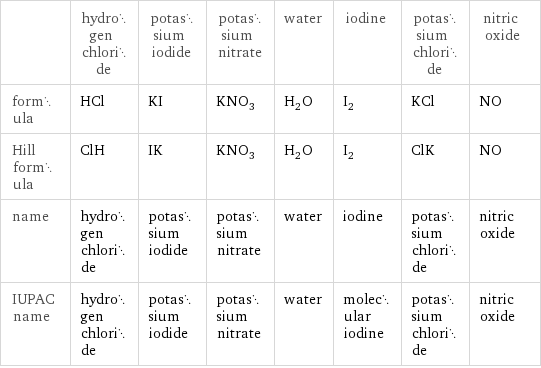Input interpretation

HCl hydrogen chloride + KI potassium iodide + KNO_3 potassium nitrate ⟶ H_2O water + I_2 iodine + KCl potassium chloride + NO nitric oxide
Balanced equation

Balance the chemical equation algebraically: HCl + KI + KNO_3 ⟶ H_2O + I_2 + KCl + NO Add stoichiometric coefficients, c_i, to the reactants and products: c_1 HCl + c_2 KI + c_3 KNO_3 ⟶ c_4 H_2O + c_5 I_2 + c_6 KCl + c_7 NO Set the number of atoms in the reactants equal to the number of atoms in the products for Cl, H, I, K, N and O: Cl: | c_1 = c_6 H: | c_1 = 2 c_4 I: | c_2 = 2 c_5 K: | c_2 + c_3 = c_6 N: | c_3 = c_7 O: | 3 c_3 = c_4 + c_7 Since the coefficients are relative quantities and underdetermined, choose a coefficient to set arbitrarily. To keep the coefficients small, the arbitrary value is ordinarily one. For instance, set c_3 = 1 and solve the system of equations for the remaining coefficients: c_1 = 4 c_2 = 3 c_3 = 1 c_4 = 2 c_5 = 3/2 c_6 = 4 c_7 = 1 Multiply by the least common denominator, 2, to eliminate fractional coefficients: c_1 = 8 c_2 = 6 c_3 = 2 c_4 = 4 c_5 = 3 c_6 = 8 c_7 = 2 Substitute the coefficients into the chemical reaction to obtain the balanced equation: Answer: | | 8 HCl + 6 KI + 2 KNO_3 ⟶ 4 H_2O + 3 I_2 + 8 KCl + 2 NO
Structures

+ + ⟶ + + +
Names

hydrogen chloride + potassium iodide + potassium nitrate ⟶ water + iodine + potassium chloride + nitric oxide
Reaction thermodynamics
Enthalpy

| hydrogen chloride | potassium iodide | potassium nitrate | water | iodine | potassium chloride | nitric oxide molecular enthalpy | -92.3 kJ/mol | -327.9 kJ/mol | -494.6 kJ/mol | -285.8 kJ/mol | 0 kJ/mol | -436.5 kJ/mol | 91.3 kJ/mol total enthalpy | -738.4 kJ/mol | -1967 kJ/mol | -989.2 kJ/mol | -1143 kJ/mol | 0 kJ/mol | -3492 kJ/mol | 182.6 kJ/mol | H_initial = -3695 kJ/mol | | | H_final = -4453 kJ/mol | | | ΔH_rxn^0 | -4453 kJ/mol - -3695 kJ/mol = -757.7 kJ/mol (exothermic) | | | | | |
Gibbs free energy

| hydrogen chloride | potassium iodide | potassium nitrate | water | iodine | potassium chloride | nitric oxide molecular free energy | -95.3 kJ/mol | -324.9 kJ/mol | -394.9 kJ/mol | -237.1 kJ/mol | 0 kJ/mol | -408.5 kJ/mol | 87.6 kJ/mol total free energy | -762.4 kJ/mol | -1949 kJ/mol | -789.8 kJ/mol | -948.4 kJ/mol | 0 kJ/mol | -3268 kJ/mol | 175.2 kJ/mol | G_initial = -3502 kJ/mol | | | G_final = -4041 kJ/mol | | | ΔG_rxn^0 | -4041 kJ/mol - -3502 kJ/mol = -539.6 kJ/mol (exergonic) | | | | | |
Equilibrium constant
![Construct the equilibrium constant, K, expression for: HCl + KI + KNO_3 ⟶ H_2O + I_2 + KCl + NO Plan: • Balance the chemical equation. • Determine the stoichiometric numbers. • Assemble the activity expression for each chemical species. • Use the activity expressions to build the equilibrium constant expression. Write the balanced chemical equation: 8 HCl + 6 KI + 2 KNO_3 ⟶ 4 H_2O + 3 I_2 + 8 KCl + 2 NO Assign stoichiometric numbers, ν_i, using the stoichiometric coefficients, c_i, from the balanced chemical equation in the following manner: ν_i = -c_i for reactants and ν_i = c_i for products: chemical species | c_i | ν_i HCl | 8 | -8 KI | 6 | -6 KNO_3 | 2 | -2 H_2O | 4 | 4 I_2 | 3 | 3 KCl | 8 | 8 NO | 2 | 2 Assemble the activity expressions accounting for the state of matter and ν_i: chemical species | c_i | ν_i | activity expression HCl | 8 | -8 | ([HCl])^(-8) KI | 6 | -6 | ([KI])^(-6) KNO_3 | 2 | -2 | ([KNO3])^(-2) H_2O | 4 | 4 | ([H2O])^4 I_2 | 3 | 3 | ([I2])^3 KCl | 8 | 8 | ([KCl])^8 NO | 2 | 2 | ([NO])^2 The equilibrium constant symbol in the concentration basis is: K_c Mulitply the activity expressions to arrive at the K_c expression: Answer: | | K_c = ([HCl])^(-8) ([KI])^(-6) ([KNO3])^(-2) ([H2O])^4 ([I2])^3 ([KCl])^8 ([NO])^2 = (([H2O])^4 ([I2])^3 ([KCl])^8 ([NO])^2)/(([HCl])^8 ([KI])^6 ([KNO3])^2)](../image_source/f257f662393666aed39569ba9e4e9031.png)
Construct the equilibrium constant, K, expression for: HCl + KI + KNO_3 ⟶ H_2O + I_2 + KCl + NO Plan: • Balance the chemical equation. • Determine the stoichiometric numbers. • Assemble the activity expression for each chemical species. • Use the activity expressions to build the equilibrium constant expression. Write the balanced chemical equation: 8 HCl + 6 KI + 2 KNO_3 ⟶ 4 H_2O + 3 I_2 + 8 KCl + 2 NO Assign stoichiometric numbers, ν_i, using the stoichiometric coefficients, c_i, from the balanced chemical equation in the following manner: ν_i = -c_i for reactants and ν_i = c_i for products: chemical species | c_i | ν_i HCl | 8 | -8 KI | 6 | -6 KNO_3 | 2 | -2 H_2O | 4 | 4 I_2 | 3 | 3 KCl | 8 | 8 NO | 2 | 2 Assemble the activity expressions accounting for the state of matter and ν_i: chemical species | c_i | ν_i | activity expression HCl | 8 | -8 | ([HCl])^(-8) KI | 6 | -6 | ([KI])^(-6) KNO_3 | 2 | -2 | ([KNO3])^(-2) H_2O | 4 | 4 | ([H2O])^4 I_2 | 3 | 3 | ([I2])^3 KCl | 8 | 8 | ([KCl])^8 NO | 2 | 2 | ([NO])^2 The equilibrium constant symbol in the concentration basis is: K_c Mulitply the activity expressions to arrive at the K_c expression: Answer: | | K_c = ([HCl])^(-8) ([KI])^(-6) ([KNO3])^(-2) ([H2O])^4 ([I2])^3 ([KCl])^8 ([NO])^2 = (([H2O])^4 ([I2])^3 ([KCl])^8 ([NO])^2)/(([HCl])^8 ([KI])^6 ([KNO3])^2)
Rate of reaction
![Construct the rate of reaction expression for: HCl + KI + KNO_3 ⟶ H_2O + I_2 + KCl + NO Plan: • Balance the chemical equation. • Determine the stoichiometric numbers. • Assemble the rate term for each chemical species. • Write the rate of reaction expression. Write the balanced chemical equation: 8 HCl + 6 KI + 2 KNO_3 ⟶ 4 H_2O + 3 I_2 + 8 KCl + 2 NO Assign stoichiometric numbers, ν_i, using the stoichiometric coefficients, c_i, from the balanced chemical equation in the following manner: ν_i = -c_i for reactants and ν_i = c_i for products: chemical species | c_i | ν_i HCl | 8 | -8 KI | 6 | -6 KNO_3 | 2 | -2 H_2O | 4 | 4 I_2 | 3 | 3 KCl | 8 | 8 NO | 2 | 2 The rate term for each chemical species, B_i, is 1/ν_i(Δ[B_i])/(Δt) where [B_i] is the amount concentration and t is time: chemical species | c_i | ν_i | rate term HCl | 8 | -8 | -1/8 (Δ[HCl])/(Δt) KI | 6 | -6 | -1/6 (Δ[KI])/(Δt) KNO_3 | 2 | -2 | -1/2 (Δ[KNO3])/(Δt) H_2O | 4 | 4 | 1/4 (Δ[H2O])/(Δt) I_2 | 3 | 3 | 1/3 (Δ[I2])/(Δt) KCl | 8 | 8 | 1/8 (Δ[KCl])/(Δt) NO | 2 | 2 | 1/2 (Δ[NO])/(Δt) (for infinitesimal rate of change, replace Δ with d) Set the rate terms equal to each other to arrive at the rate expression: Answer: | | rate = -1/8 (Δ[HCl])/(Δt) = -1/6 (Δ[KI])/(Δt) = -1/2 (Δ[KNO3])/(Δt) = 1/4 (Δ[H2O])/(Δt) = 1/3 (Δ[I2])/(Δt) = 1/8 (Δ[KCl])/(Δt) = 1/2 (Δ[NO])/(Δt) (assuming constant volume and no accumulation of intermediates or side products)](../image_source/8f392d66741f11a2885c6f251bfb40fb.png)
Construct the rate of reaction expression for: HCl + KI + KNO_3 ⟶ H_2O + I_2 + KCl + NO Plan: • Balance the chemical equation. • Determine the stoichiometric numbers. • Assemble the rate term for each chemical species. • Write the rate of reaction expression. Write the balanced chemical equation: 8 HCl + 6 KI + 2 KNO_3 ⟶ 4 H_2O + 3 I_2 + 8 KCl + 2 NO Assign stoichiometric numbers, ν_i, using the stoichiometric coefficients, c_i, from the balanced chemical equation in the following manner: ν_i = -c_i for reactants and ν_i = c_i for products: chemical species | c_i | ν_i HCl | 8 | -8 KI | 6 | -6 KNO_3 | 2 | -2 H_2O | 4 | 4 I_2 | 3 | 3 KCl | 8 | 8 NO | 2 | 2 The rate term for each chemical species, B_i, is 1/ν_i(Δ[B_i])/(Δt) where [B_i] is the amount concentration and t is time: chemical species | c_i | ν_i | rate term HCl | 8 | -8 | -1/8 (Δ[HCl])/(Δt) KI | 6 | -6 | -1/6 (Δ[KI])/(Δt) KNO_3 | 2 | -2 | -1/2 (Δ[KNO3])/(Δt) H_2O | 4 | 4 | 1/4 (Δ[H2O])/(Δt) I_2 | 3 | 3 | 1/3 (Δ[I2])/(Δt) KCl | 8 | 8 | 1/8 (Δ[KCl])/(Δt) NO | 2 | 2 | 1/2 (Δ[NO])/(Δt) (for infinitesimal rate of change, replace Δ with d) Set the rate terms equal to each other to arrive at the rate expression: Answer: | | rate = -1/8 (Δ[HCl])/(Δt) = -1/6 (Δ[KI])/(Δt) = -1/2 (Δ[KNO3])/(Δt) = 1/4 (Δ[H2O])/(Δt) = 1/3 (Δ[I2])/(Δt) = 1/8 (Δ[KCl])/(Δt) = 1/2 (Δ[NO])/(Δt) (assuming constant volume and no accumulation of intermediates or side products)
Chemical names and formulas

| hydrogen chloride | potassium iodide | potassium nitrate | water | iodine | potassium chloride | nitric oxide formula | HCl | KI | KNO_3 | H_2O | I_2 | KCl | NO Hill formula | ClH | IK | KNO_3 | H_2O | I_2 | ClK | NO name | hydrogen chloride | potassium iodide | potassium nitrate | water | iodine | potassium chloride | nitric oxide IUPAC name | hydrogen chloride | potassium iodide | potassium nitrate | water | molecular iodine | potassium chloride | nitric oxide